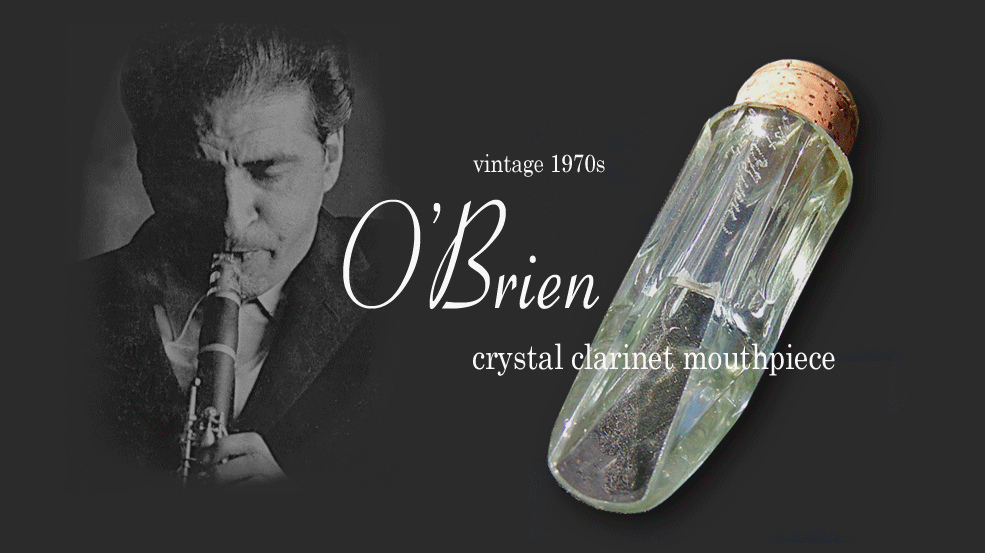O’Brien originally made the Selmer Clarion crystal mouthpieces. Identified by
only a couple of flutes (indentations on the side of the mouthpiece).
The O’Brien mouthpieces quality varied over the years. In the early
1980s a cousin of the original O’Brien created mouthpieces from time to time.
These mpcs were not considered the “prime” mpcs
Earlier mpcs the glass could be slightly darker, even slightly pink. On
many of these models their would be a date etched on the glass. The
original mpcs from the early 1940s, made by the Harry O’Brien, were less clear
and had more air bubbles. So I guess the more “pure” the crystal in the
mpc the less desireable they are.
There was also a mold change in the 1950s as the original mold was broken.
The older mold had 3 grooves on each side (6 total). The newer 1960’s mold had 1
groove on each side. The original Harry O’Brien (passed away in the 1950s)
and he also manufactured clarinets. The son continued to make Selmer Primer
clarinets in the 1940s as the father stopped. Pete Fountain apparently
used these clarinets along with the mouthpieces. (thanks for this
information goes to Michael E Obrien, grandson of Harry O'Brien - if you
read this please email me, your address changed)
OCB stood for “Off Center Bore”. These models were popular with jazz and
classical clarinetists during the 1950s through the 1980s. O’Brien is said
to have put really good facings on his mouthpieces. In general it’s thought that O’Brien has been underrated as an artists just because of his status as a
manufacturer and retailer. Tony Scott (pictured below) played a crystal
mouthpiece during his jazz recordings years in the 1950s and 1960s. The
OB* was described as a “medium” and his most popular facing.
| IDENTIFICATION | TIP OPENING (varies) |
| No 1 | Very short, Close |
| No 2 | Medium, French |
| No * | 1.00mm Very Popular |
| No 2* | More open than OB* |
| No 3 | 1.16mm |
| No 3* | |
| No 4 | 1.19mm |
| No 4* | |
| No 5 | 1.25mm |
| No 5* | the most open |

Some past tip openings of mpcs I’ve had
| Model | Tip Opening | Facing length |
| 5 | .047″ | 16.5mm |
| 5* | .044″ | 16mm |
| 5 | .054″ | 17mm |
| 5 | .043″ | 14mm |
Selmer Clarion
Very Early model:
Selmer model
This is a beautiful sounding O’Brien. I thought my 1980 model sounded
good. This Selmer O’Brien (found with an old silver plated metal clarinet) sounds absolutely
beautiful – rivaling my certain 1920-30s mouthpieces. This is probably from the
original mold, pre 1950s. Response and tone is extraordinary across the range from low E to altissimmo.
1955 model – The original mpc came in cardboard tubes.
Later ones came in plastic tubes with a sheet of paper in them (similar to the
label below).
O’Brien “5” model – O’Brien and 5 etched on the top
of the body (not on the table). No end cap. Frosted table and no
identification etchings on the table. This was a very freeblowing O’Brien with a
nice larger tip opening. This is probably from 1950s or 1960s
tip opening 1.25mm
1970s model – This has the same visual identification as the
1980 model. Looks nearly exactly the same, 3 flutes on either side, brass
end cap, etc though the crystal is not as clear. O’Brien is etched
on the table. In the upper left “x4” is etched and on the lower left “OCB-70” is
etched. Tip opening = 1.19mm (0.04865 of an inch). 16mm length facing.
1972 model – This has the same visual identification as the 1980
model. Looks nearly exactly the same, 3 flutes on either side, brass end
cap, etc though the crystal is not as clear. O’Brien is etched
on the table. In the lower left “OCB*-72” is etched.
1980 model – easily recognizable with the brass cap on the end
of the tenon.
3 flutes on either side. “3x” scribe on upper left of table; “OCB-80.”
scribed on lower left of table. “OBrien” scribed in middle right of
table”. Brass tenon cap. Purchased in 1980 from WoodWind Inc.
(of Woodwind and Brasswind), original cork. Tip opening = 1.16mm (0.04567
of an inch)








_small.jpg)



















